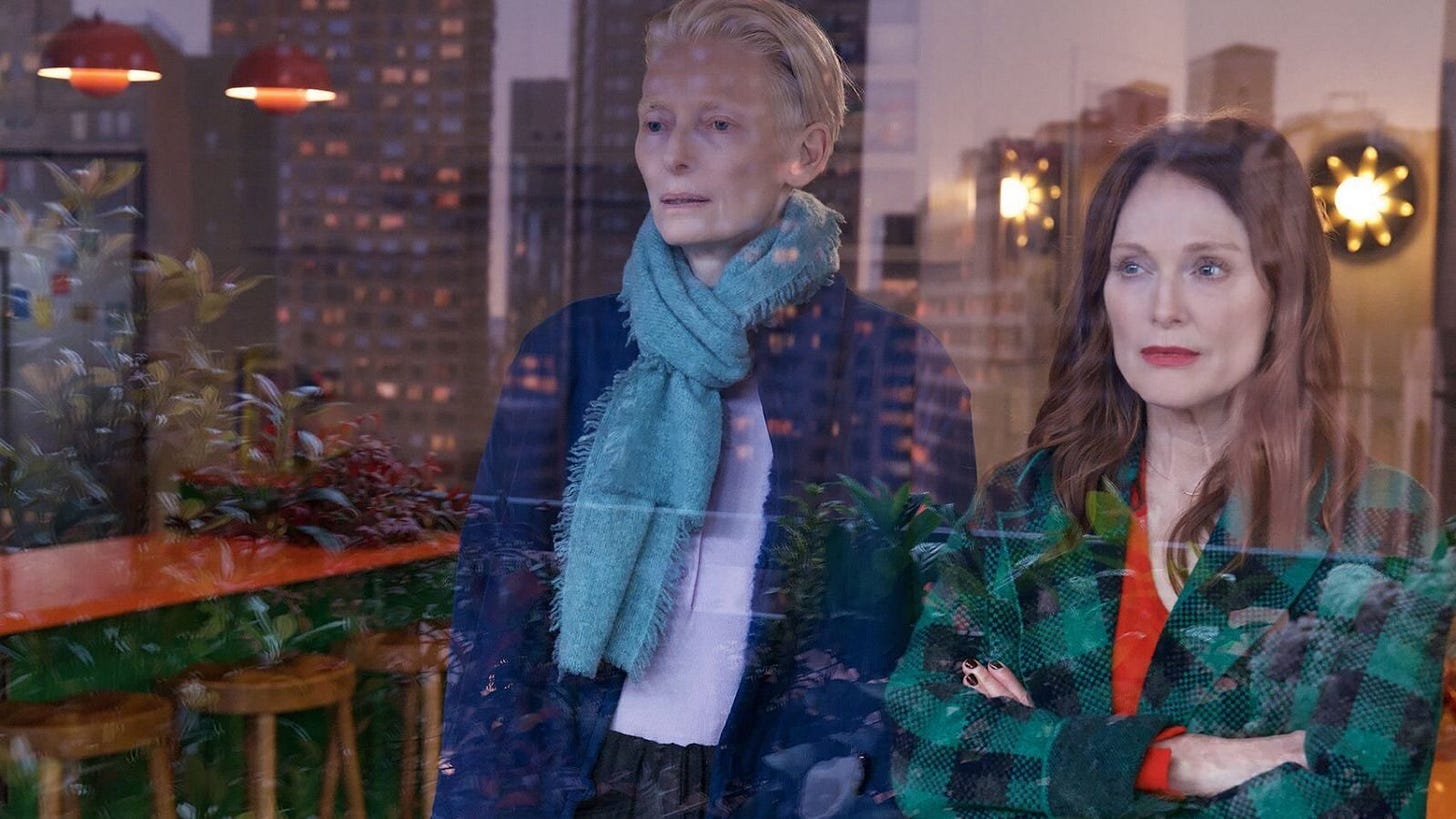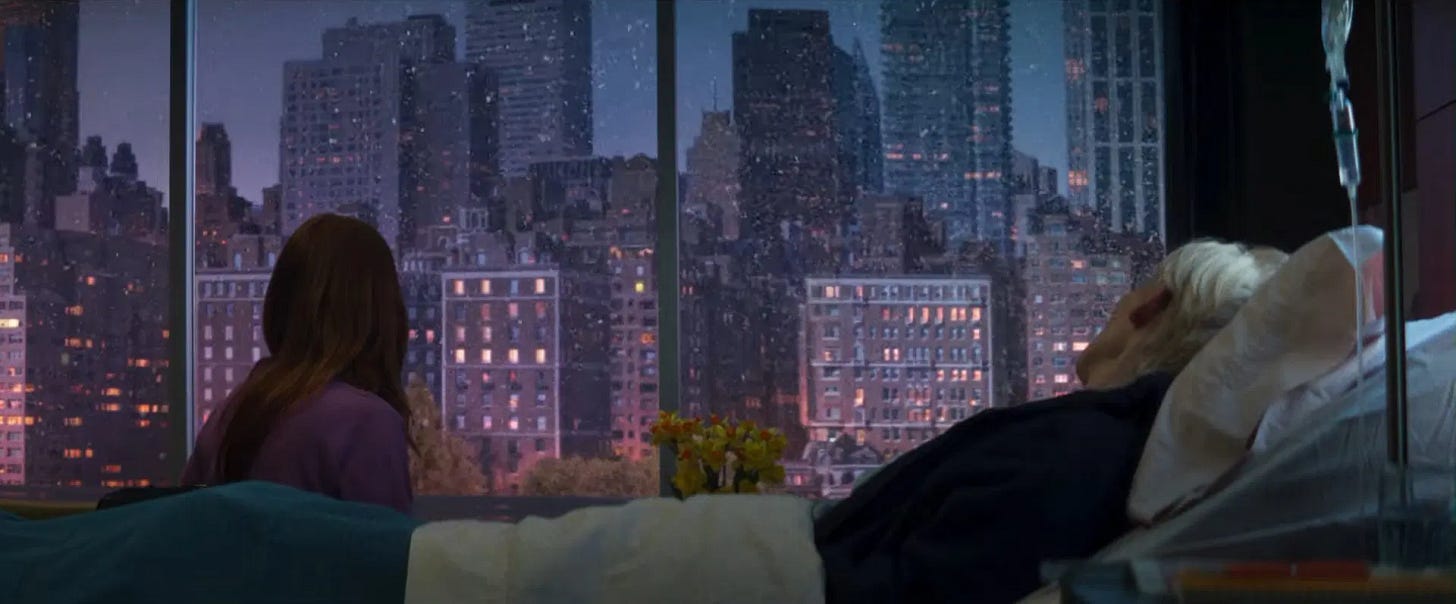Review - The Room Next Door
His first feature film in the English language, Pedro Almodóvar gives into subtle provocations through a straightforward melodrama of the beauty of life and death.
Spanish director Pedro Almodóvar truly needs no introduction. He is one of the most highly recognized filmmakers in world cinema and has made more than 20 films in 40+ years, focusing on comedies, melodramas, thrillers and many times something in between.
This is the first time he made a feature film not in his native Spanish language, and he fully took advantage of the opportunity, casting maybe two of the best working actresses today: Julianne Moore and Tilda Swinton. The result is his first ever Golden Lion winner (the first place award at the Venice Film Festival). It is out in theaters now in Venezuela and Europe (it will get a release in late December in the US) so give it a watch if you can.
A Life-Affirming Death: Pedro Almodóvar’s The Room Next Door
Production from Spain. Released in 2024.
Health is often taken for granted as a necessary element to truly enjoy life and the little things that it offers. From the joy of reading and writing to appreciating the art of film, music and theater, to cooking and enjoying a good meal, and of course the thrill of physical activity and sports, none are the same when we are not healthy enough to partake in them. If the joy of life is taken that way, with no clear way of returning to a state of health, is that prolonged life of suffering truly worth living through? That question has religious, moral and spiritual implications, of course, and in the case of Pedro Almodóvar, he decided to explore that question as one of self-determination and dignity, following a person who lived life to the fullest and agonized over not being able to enjoy the little good things anymore.
I often have difficulty with Almodóvar’s work -despite his obvious talent- because of how he chooses to tell his stories, which rely on contrivance and twists within the melodrama genre, and eventual get to an ending point that, for me, rarely pays off what he set out to do. Talk to Her is one such example, a very celebrated film by watchers and academics alike, I found its central conceit jarring, its story never truly transcending its high concept, the characters interesting but never truly watchable, and the many twists serving the story at the expense of character or thematic depth. I feel the same for others of his films, like Bad Education and The Law of Desire (with the latter being very entertaining nonetheless). Those films that do become worthwhile for me are those that not necessarily escape the contrivances, but rather that achieve thematic depth through the fundamentals of melodrama and its central contradiction: artificiality and emotional truth.
All About My Mother is probably the best example and his best work, a film dedicated to motherhood and womanhood, and whose many twists and new side stories all serve the central idea of the complexity and beauty of all kinds of women, while never sacrificing what made each character so fascinating. Despite its smaller scale, The Room Next Door achieves the same kind of success, because it lets go of contrivance or twists and turns, and relies on the power of his actors, and small, but effective, side stories, to make his point and go beyond it.
The film follows Julianne Moore as Ingrid, an author afraid of death, who reconnects with her past co-worker and friend Martha, played by Tilda Swinton, who has terminal cancer. The story first focuses on their reconnection through Ingrid’s many visits to the hospital in New York where Martha is being treated, and then shifts to a house in the countryside, where Martha plans to take her own life. It sounds overly dramatic, and sometimes it does get to those highs, but Almodóvar’s skillful writing lets his characters, and the audience, breathe through humor and other moments of levity through the enjoyment of literature, film and art.
The trademark of Almodóvar’s style is all there: the immaculate red tinted sets in the three main locations the film develops in, the cutaways to flashbacks that give context in a cheeky manner, and the occasional moments of high dramatic tension, which are accompanied by very unexpected funny moments. The inherent artificiality of Almodóvar’s sets, more so than his other films, remind me of the purpose served through Douglas Sirk’s films, and to some degree, Todd Haynes as well. It all seems deeply artificial in how the spaces are constructed, even extended to the elements present in the film catalogs. However, that artificiality is an act of defiance, removing any expectation of realism in favor of mining for an emotional truth, as did Sirk in his masterpiece All That Heaven Allows through his exploration of prejudice. Here, of course, the main idea is that of dying with dignity and removing agony as much as possible, and as Almodóvar peels the intentionally stilted dialogue, the perfectly combined colors, the asides and the dollhouse sets, every element serves to drive home this point of enjoying life, but recognizing the moments where it becomes truly impossible.
The magic comes, however, in both the actresses’ deliveries and Almodóvar’s own direction, as a less skillful team would have made this material very heavy-handed -especially as it integrates themes of climate change relating to a life of dignity- but this film never feels quite ham-fisted in its delivery, but softer, quieter and more nuanced in its perspective in such a controversial topic. Instead of preaching the need for euthanasia as a right for people in complicated health-related conditions, the film explores the nature of suffering and enjoyment in equal measure. Martha gets many moments to make the viewers laugh as she herself tries to keep herself in good spirits, but when the moments come of her losing her concentration and ability to enjoy a good book, that pain is deeply felt.
And for Ingrid, who explores the moral complexity of her own role in Martha’s suicide, the nuance is even greater. From the very beginning the viewers are told of her fear of death, seeing it as her not accepting why beautiful things must have an end. Of course, as she reconnects with Martha and eventually decides to help her, she does it out of the goodness of her heart but also because she realizes how the cancer sucks up all of the beauty left in Martha’s eyes. Her side story lies in her friendship with Damian, played by John Turturro, who is a celebrated academic fully depressed by the world ending through climate change. His role serves two purposes, apart from feeling like a fully-fledged character: he serves as a contrast for Ingrid’s own humanity and drive to accompany their loved ones, but also, in a more urgent sense, her reminds Ingrid of the very real possibility of her being subject to a legal procedure for aiding and abetting a euthanasia procedure.
If death is a natural process that will occur anyways to Martha as the cancer continues to take over, why not let her die on her own terms, with the least amount of suffering possible? I ask myself: if hospice care consists of letting the terminal patient die of natural causes without providing the care needed to prolong their life, is that passive way of helping any different from actively seeking out a painless death when it becomes inevitable? What is the difference then, and why do people have to cower over their role in being a good friend if the eventual death is as consensual as the hospice care many are put through to die gruesomely? As the film reaches its closing moments, Ingrid gets a taste of what could’ve happened to her legally if she and Martha had not taken the right measures to protect her legal integrity, but the point is, of course, that in some cases it is truly absurd to deny any person the possibility to maintain their dignity, through life and through death.
The closing moments of the film are the most magical, as a brilliant casting choice that I won’t spoil reminds us that even in death, Martha’s life full of professional accomplishments and loved ones -despite complicated relationships- make her presence felt. As the snow starts falling when Ingrid lies down beside the pool in the house Ingrid and Martha spent many moments together, the film reaches its emotional conclusion: one as the ultimate celebration of a life well lived, and the dignity of self-determination in all forms. Through its subtle power, I could not help but shed a tear, despite the film asking me not to. This is maybe one of my favorite films from Almodóvar yet.







